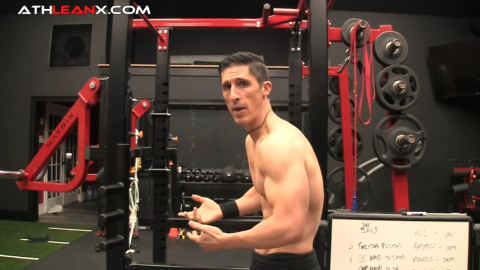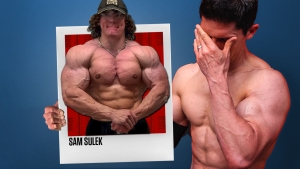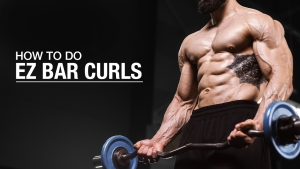
ABS AND OBLIQUES STRETCH
Ever wonder if your squat is suffering from your own tight abs? It’s very possible!
Tight core muscles (aka abs) can create a lot of dysfunction in your other lifts.
The muscles in your core, particularly your internal and external obliques, and your rectus abdominis – the six-pack muscle – can actually cause a problem for other lifts if those abdominal muscles are allowed to become short and tight from overwork and sitting.
In this article, I’m going to show you three abdominal stretches that can help your overall posture and exercise performance.
But before we delve into the stretching exercises, first let’s talk about WHY abs get tight in the first place.
Tight abs are actually a common problem due to some of our training tendencies and lifestyle factors. Read on to learn more about what causes the tight abs that might be hurting some of your big lifts.
WHY ABS GET TIGHT
Abdominal muscles become short and tight pretty easily because of two things.
Number one: we work out our abs a lot but seldom stretch them.
Secondly: we sit a lot. Either we’re driving in a car on our commute to work, or while we’re at work we’re sitting. We’re sitting a lot.
Sitting this much allows these abdominal muscles to become tight. So, abs can get short and tight even when we don’t work them out.
Realize that the abdominal muscles all perform the same function: they bring the rib cage toward the pelvis. They originate and attach those two bony structures. Side note here: they do not raise the legs, which is why leg raises do not dynamically exercise the abs.
When abs get tight, they bring the rib cage and pelvis closer together even in a resting state.
What does this cause? Your posture can look like the picture above. Tight abs is where a lot of postural issues begin and they can lead to problems we attribute to other causes. For instance, we see people with rounded shoulders and say “Oh, they can’t extend their thoracic spine”, or maybe “they’ve got overdeveloped tight pecs and lats, and that’s rolling their shoulders forward”.
But, the true culprit may be tight abs. Let’s take a look at a few great ways to stretch the abs and eliminate the imbalances that can come from tight abs.
THREE STRETCHES TO LOOSEN TIGHT ABS
To start addressing a tight ab problem, try these three exercises, all of which are done using an exercise ball.
Add an exercise mat if you’re working on a concrete floor as some of these stretches will have your feet on their sides, which could get uncomfortable.
You don’t have to do these stretches often because you’re probably not stretching them at all right now.
The idea with all three of these abdominal stretches is to separate your upper body from your lower body as far as possible by using an exercise ball as the fulcrum.
RECTUS ABDOMINIS STRETCH

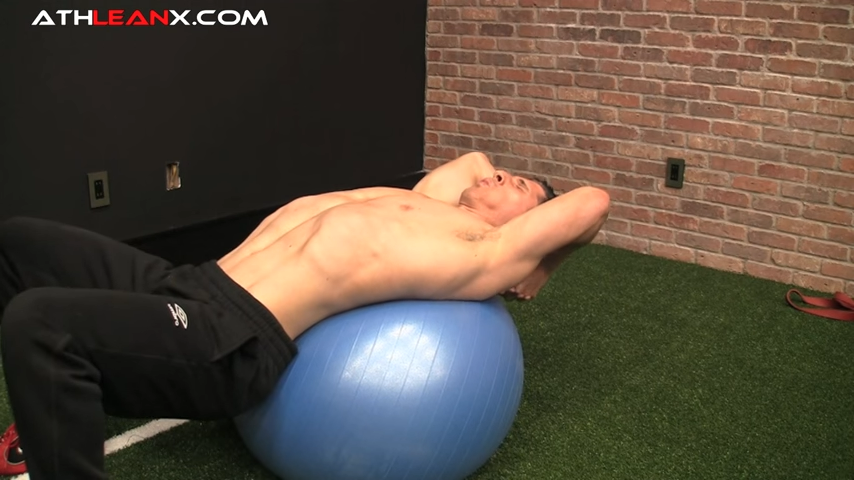
To stretch the rectus abdominis muscle, you’ll do a stretch that’s a bit like the cat cow stretch, only facing up. You’re going to be using the exercise ball to help you create that arch.
Your starting position is face up on top of the exercise ball, arms extended behind you, feet hip width apart flat on the floor.
Lie across the top of an exercise ball that’s large enough for you to be able to stretch across it. A 65cm diameter ball makes a good choice for most adults. A Bosu Ball will not suffice.
You may have done exercise ball stretches before, but for these abdominal stretches, you’ll need to follow a couple of specific cues to get the form right.
Your first cue is to feel your rib cage stretch away from your pelvis.
Now, roll your hips forward slightly for the second cue, which is feeling your midsection stretch over the edge of the ball. You’ll feel the muscle tension release as you do this.
Finally, once you’re in position and your ribcage is expanded into a comfortable stretch, you can progress the stretch by pushing your arms up over your head, and then dropping your hips even farther toward the floor to feel an even deeper stretch.

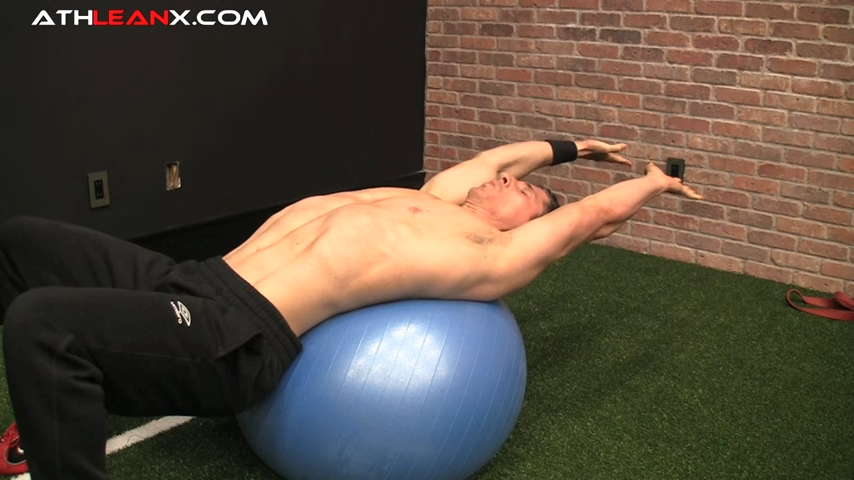
Dropping your pelvis father from the rib cage produces a maximum stretch on the rectus abdominis. Intensify that further with a deep breath. That expands your rib cage which in turn pulls a bit more on the rectus.
EXTERNAL OBLIQUE STRETCH
The internal and external obliques are big muscle groups that are oriented diagonally across your midsection, and impact posture in different ways, so you’re going to want to stretch them too.
The external oblique muscle originates at the ribs and inserts along the pelvis.


Your starting position is on top of the exercise ball on your side, with one arm bracing your upper body on the ball and the other arm extended overhead.
Legs should be comfortably extended but supporting you as you lie on the exercise ball. The side of your foot will be on the floor. So, when you’re stretching your right side, the side of your left foot will be on the floor. Because you’ll be using the sides of your feet, an exercise mat might make this more comfortable.
Stretch your external obliques more by turning over on your side across the ball. Work to separate your rib cage and pelvis. Drop them as far away from each other as you possibly can.

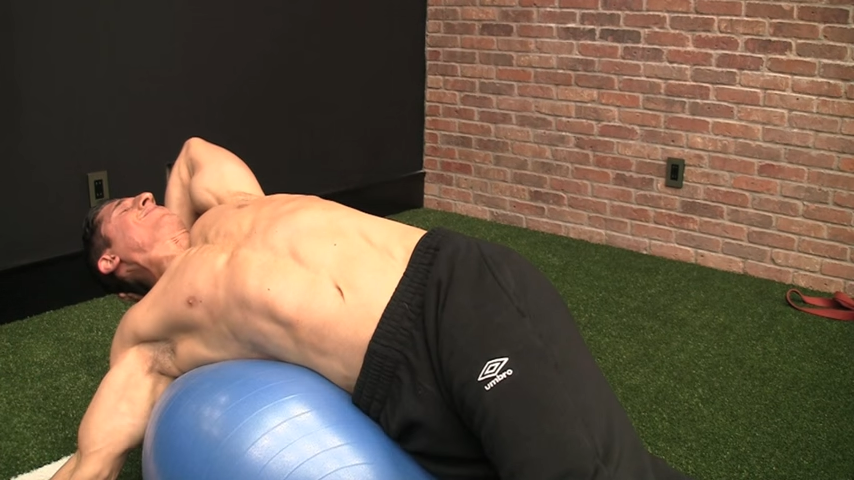
For a deeper stretch of the external obliques, twist a little bit and lean back when you’re over the ball. This pulls them further away from the natural angle that they run between the rib cage and the pelvis where the external obliques connect.
Switch sides to stretch the contra-lateral obliques.
INTERNAL OBLIQUE STRETCH


The internal oblique muscle, unlike the external, originates at the hips and inserts at the ribs, but you’ll use the same logic for stretching them as for the externals.
Begin from the same basic starting position.
Apply the same technique. Just roll yourself down a little bit while maintaining that side bend, to isolate the internal obliques’ attachment to the iliac crest on the side of your hip.
Work to move the rib cage and hips away from each other rotating downward, using a twisting motion. Roll your shoulders and upper body forward as you roll your hips backward. You’ll get a deeper stretch the farther apart your hips and rib cage roll away from each other.
Do these three abdominal stretches and you’ll notice the benefits in your entire exercise routine.
WHERE YOU’LL NOTICE BENEFITS OF AB STRETCHING
The squat may be the best example of a lift that’s affected badly by tight abs.
Tight abs can create a posterior tilt of the hips. If you try to squat out of the posterior tilt you’re immediately putting your low back in jeopardy of injuries because you’re in a very compromised unstable position.
You will want some anterior tilt in your squat form to compensate for the load on your lower back. Moderate anterior tilt (as pictured here) reduces risk of injury when performing heavy-loaded exercises.

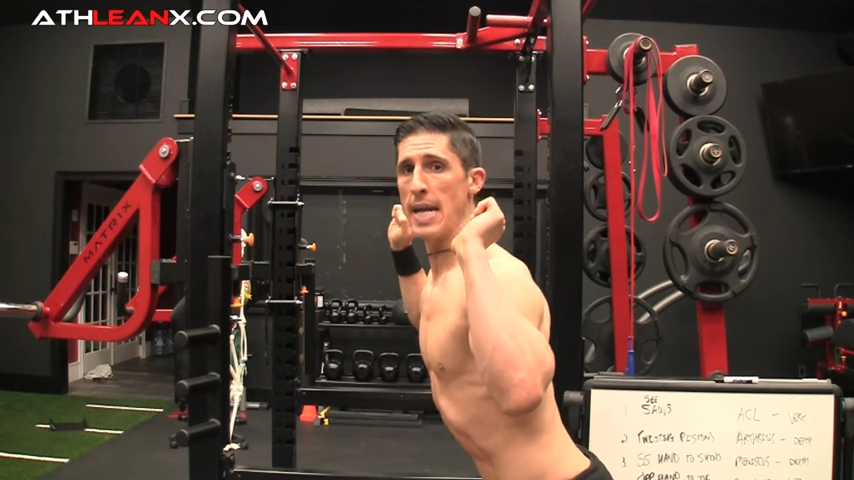
As you lean forward to begin the squat, an anterior tilt also positions the bar correctly. Think of an imaginary line that runs downward from the bar through the middle of your feet. This creates a strong position for squatting.
You’re only going to get that favorable center of mass if you have an anterior tilt.
There are other exercises besides the squat that can be negatively impacted by overly-tight abs. We’re just focusing on squats here to make the point.
To summarize, you stretch other muscles in your body, and your abs are no less important, especially once you realize the implications of not stretching them.
As a final reminder, stretching is best done at the end of a workout and not before you’re sufficiently warmed up. Stretching a cold muscle can injure it. Stretch your abs at the close of your abdominal workout, or any workout for that matter!
If you’re looking for a training program that leaves no muscle or area behind, you’ve come to the right place. Check out our ATHLEAN-X programs to see which one best fitness your goals and fitness level!

- We routinely stretch major muscle groups all over our bodies, but often neglect stretching the abs after a workout.
- Tight abs can negatively impact your training through their negative influence on proper posture and exercise mechanics, like on the squat.
- Try three abdominal stretches to remedy this: one for the rectus abdominis and two for the obliques, internal and external.
- All three stretches require an exercise ball. Select a ball large enough for you to get a full stretch as you lean over it.
- The thing to keep in mind for all three stretches is positioning your body to get the rib cage to separate as far as possible from the abs’ attachments on the pelvis.
- Extending the arms overhead, dropping the hips, and taking a deep breath accentuates the stretches.
HOW TO STRETCH ABS FAQ
To stretch the abs (aka core muscles), you basically need to either arch or twist your back using a controlled movement that causes the upper body to move away from the hips.
There are a handful of other options to stretch the abdominal muscles. The cat-cow stretch is a very well-known dynamic stretch, done from the hands and knees by arching the back as high as possible (the cat phase) and then immediately pushing the belly button toward the floor as far as possible while flexing the back (the cow phase) in a continuous movement. Cat poses and cow poses can be done independently, of course.
If you do leg raises for your abs, you will need to do hip flexor stretches. I hate to break it to you: leg raises do not dynamically work the abs. They work the hip flexors. The abdominal muscles do not move the legs. Leg raises cause the core muscles to work isometrically to stabilize the lumbar spine during a leg raise.
As we’ve mentioned, there are several good ways to stretch your abs. We like the exercise ball movements for rectus abdominis and oblique muscles. But there are others.
Follow a few concepts in muscle stretching for all your core stretches.
- Avoid jerky movements. Jerky movements can put your lumbar spine at risk of injury.
- Stretch as far as your natural ration of motion will allow. You should never feel unnecessary pressure in your back.
- Don’t stretch a cold muscle. It’s best to stretch your abdominal muscles at the end of an abdominal workout.
Hold static stretches for 20-30 seconds. As you get better at doing them, you can increase hold times from 20-60 seconds.
To begin with, there is no such thing as the “lower abs”. All abdominal muscles connect between the ribs and the pelvis. A good abs stretch that uses a full range of motion will make you feel it in the lower area down near your hips.
If you stretch your abs correctly, you’ll also be stretching what some refer to (incorrectly) as the lower abs.
To specifically target the lower area of your core muscles where they meet the hips, use abdominal stretches that require your hips to move away from your rib cage. For the exercise ball stretches we’ve covered here, you would do that by dropping your hips over the side of the ball, as far toward the floor as possible.
If you were using more traditional stretches–say a traditional yoga position like the Cobra stretch–you would concentrate on rolling your pelvis forward and arching your lumbar spine. You have to be careful to not over-arch your back.

Jeff Cavaliere M.S.P.T, CSCS
Jeff Cavaliere is a Physical Therapist, Strength Coach and creator of the ATHLEAN-X Training Programs and ATHLEAN-Rx Supplements. He has a Masters in Physical Therapy (MSPT) and has worked as Head Physical Therapist for the New York Mets, as well as training many elite professional athletes in Major League Baseball, NFL, MMA and professional wrestling. His programs produce “next level” achievements in muscle size, strength and performance for professional athletes and anyone looking to build a muscular athletic physique.

















